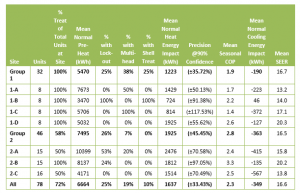 CMC Energy Services, Inc. (CMC) is excited to present our findings for the ComEd Cold Climate Ductless Heat Pump (ccDHP) pilot and overall conclusions for expanding the pilot to more ComEd customers. The pilot was administered by CLEAResult and implemented by CMC Energy Services, Inc. (CMC). CMC project partners included Franklin Energy to identify and recruit buildings, Mitsubishi Electric to procure high performance ccDHPs, Four Seasons HVAC to install ccDHP units, and Mad Dash to provide sub-metering installation support, cellular services, and smart thermostat connectivity.
CMC Energy Services, Inc. (CMC) is excited to present our findings for the ComEd Cold Climate Ductless Heat Pump (ccDHP) pilot and overall conclusions for expanding the pilot to more ComEd customers. The pilot was administered by CLEAResult and implemented by CMC Energy Services, Inc. (CMC). CMC project partners included Franklin Energy to identify and recruit buildings, Mitsubishi Electric to procure high performance ccDHPs, Four Seasons HVAC to install ccDHP units, and Mad Dash to provide sub-metering installation support, cellular services, and smart thermostat connectivity.
The ccDHP pilot tested displacement of resistance heat in income-eligible multifamily units with the use of ccDHPs. The specific research questions the pilot sought to address follow:
- Can ccDHP technology operate effectively to displace electric resistance heat in low- and moderate-income (LMI) multifamily buildings within the targeted climate zone?
- What is the overall energy impact for DHP technology in LMI multifamily buildings primarily using electric resistance heat?
- What is the field efficiency of ccDHP systems in harsh weather environments compared to rated efficiencies?
- What is the replicability of results and can these results be used to inform future program design while considering cost-effectiveness?
The CMC team installed 80 single-head or multi-head ccDHPs units in seven LMI multifamily buildings with existing electric baseboard heaters. The pilot was designed to test a variety of scenarios to determine how effective the ccDHPs are in the typically rugged Chicago winters. Following installation of the ccDHPs, CMC monitored systems and electricity usage and analyzed the results to determine the feasibility of extending the pilot to more homes. The analysis considered a variety of topics including cost, customer satisfaction with the heating and cooling system, effectiveness of the ccDHP in cold weather, cost-effectiveness testing and the ability to reduce costs for the DHPs through bulk purchasing and other means.
Key Findings
Of the 80 multifamily units, 78 were included in the final analysis. Two sites were removed due to inadequate pre-AMI data. CMC was able to correct for occupant turnover and heating load variations in the data.
The pilot results indicate a weather-normalized mean heating energy impact for the 78 sites of 1,637 ± 547 kWh with a precision of 33.4 percent at 90 percent confidence. This equates to a mean percentage reduction of 24.56 percent across all sites. The effect of AMI pre-heating usage (defined for this pilot as pre-evaluation period AMI heating usage) was statistically significant and accounts for 28 percent of the variation in all heating energy impacts. Sites with a mean pre-heating value of less than 4,000 kWh had a mean normalized heating energy impact of -181 kWh. Twenty sites identified as having ideal ccDHP operation with low electric resistance heating had an overall reduction of 48 percent, with a mean heating energy impact of 2,728 kWh. These sites generally had similar characteristics as those across the entire pilot, indicating occupant behavior may have driven the more positive results. The polar vortex event had a moderate impact on the pilot, with a 2.2 percent more negative heating energy impact overall for 54 sites with adequate sub-metered data, compared to removal of the event from the dataset for sites. Overall electric resistance heat use during this event was highly variable.
There was a statistically significant relationship between post electric resistance and heating energy impacts, with electric resistance use accounting for 16 percent of the variation in heating energy impacts. Evaluation period electric resistance heating use was highly variable. Twenty sites received ambient lock-out, with the rest of the participant apartments relying on customer education. Both were effective in specific scenarios, with ambient lock-out sites and some education-only sites showing above average heating energy impacts. However, the overall mean normalized heating energy impact for sites with lock-outs was 1,853 kWh, a 34 percent reduction, compared to 1,563 kWh for education-only, a 22 percent reduction.
Multi-head units showed a positive mean heating energy impact of 1,705 kWh, a 22 percent reduction, versus 1,621 kWh, a 25 percent overall reduction, for single-head systems. Multi-head installation sites had 19 percent higher pre-heating AMI usage. Linear regression predictive coefficients estimate that multi-head sites underperformed against predicted heating energy impact by 14 percent based on pre-heating AMI usage.
This aligns with lower coefficient of performance (COP) on these systems. There were instances where multi-head ccDHP units performed well, which may be a result of distribution or sizing issues in single-head applications. Calculated seasonal COP for all systems was 2.36, where single-head system COP was 2.63 and multi-head systems were 1.47. This is a significant differential; overall system COP was slightly lower on single-head systems and significantly lower on multi-head units, than stated COPs.
Shell treatment was found to be a significant factor in energy savings performance. While the sole site treated with insulation and air sealing had a mean heating energy impact of 724 kWh, a 21 percent reduction, this was a result of low pre-heating AMI usage. Linear regression predictive coefficients estimate that the building exceeded predicted heating energy impact by 51 percent based on pre-heating AMI usage.
Table 1. Pilot Summary Table

Where cooling is concerned, the DHP pilot provided a 50 percent increase in capacity. The mean cooling energy impact was negative for all sites in this study, with a mean energy impact of -349 kWh. The mean cooling energy impacts for sites beneath 500 kWh pre-cooling were negative. The mean SEER rating was 16.6, which is below stated SEER for ccDHPs installed.
Summary of Recommendations
CMC recommends the expansion of the ccDHP pilot to a full-scale program. Based on equipment performance in the pilot, ccDHPs are a viable technology for the ComEd service territory. However, considering the relative complexity of ccDHP systems, selecting a manufacturer-distributor channel with a robust technical training infrastructure in place, as well as selecting at least two highly qualified HVAC installers that specialize in installing ccDHPs, will be essential for minimizing costs and maximizing the cost effectiveness of a full-scale program.
The following are specific recommendations for improved design and delivery of a full-scale program:
Program Design
- Require all buildings approved for DHP installation in a scaled program to meet a minimum of 4,000 kWh per unit mean pre-heat usage. This will ensure less variation in results and allow ComEd to bolster cost-effectiveness for the program overall.
- Include ambient lock-out technology as part of an expanded program because it can be a cost-effective addition to ensure the appropriate level of electric resistance displacement. CMC recommends calculating load profiles and plotting de-rated DHP capacity to determine the outdoor temperature at which the electric resistance can be energized via lock-out control. This would be in place of the pilot approach, which was to use a static ambient temperature (15°F) lock-out for the control devices on 20 of the 80 ccDHP systems. This approach may have the two-fold benefit of assured occupant comfort and safety, along with encouraging the least amount of electric resistance heating usage.
- Build a clear line-of-sight into the buildings within ComEd’s territory that have electric resistance heat. While ComEd has multiple programs that touch on the targeted multifamily buildings that would benefit from ccDHPs, there does not appear to be a coordinated effort to compile that information. For example, Franklin Energy has been capturing this data (and electric water heating) during the last several years of multifamily work. Working collaboratively with ComEd, and other stakeholders, this data could be collected in a central repository that would assist program marketing campaigns and customer acquisition.
- Implement a full pre-qualification system using tools like Google Earth to grade sites (e.g., target specific suburbs, garden apartments, etc.). This will streamline the process and result in more qualified sites.
- Include a customer acquisition model where the HVAC contractor(s) joins the program energy advisors on site visits before buildings are fully admitted to the program. The ability to vet the specific building conditions and align with a suitable ccDHP application will increase the accuracy of pricing, efficiency of installation, and performance of the ccDHP systems
- Implement the program during off-peak (shoulder) months when HVAC contractors have more capacity. This will enable the contractor to keep their crews on staff and engaged, without requiring layoffs. It also will lower program costs as many HVAC contractors reduce their prices during off-peak periods by 5-10 percent. A full-scale program should also consider schedule incentives for the property owners as well. Encouraging the work to be completed during the off-peak period is less impactful for tenants and contractors so a project discount, gift card promotion or credit to utility bill should be considered in exchange for off-peak scheduling.
- Consider alternate ccDHP manufacturers, as well as establish a competitive bid process to award multiple contractors. Having multiple contractors engaged through this bid process not only generates an opportunity for competitive pricing, but also provides redundancy should one of the HVAC contractors have performance or capacity issues
Program Delivery
- Include shell retrofits—or weatherization—to make ccDHP installation sites heat pump ready. This should include insulation whenever possible.
- Allow for time to correct/adjust building conditions prior to participation. For example, during the preliminary qualification for a ccDHP program participant, if electrical panel upgrades, pre-existing code violations, health and safety concerns have been documented, they should be addressed before proceeding with the ccDHP project. This will improve the speed of ccDHP installations and the readiness of facilities.
- Focus the sales process on property managers as opposed to tenants. Property managers would have a more marketable property with the upgraded technology, and that could lead to less tenant turn-over. Income-eligible customers typically may have less interest or financial incentive to participate in a ccDHP program because many are on fixed energy rates.
- Incorporate additional on-site instruction and leave behind materials with the tenants and property managers to enhance the overall customer experience. Many of the tenants’ issues were behavioral so instruction on proper DHP operation is critical. In addition, the high rate of turnover in tenants and property managers warrants the need for leave-behind materials, and re-education for new residents. Finally, regular educational messaging to tenants could solidify the energy savings possibilities of ccDHPs.

